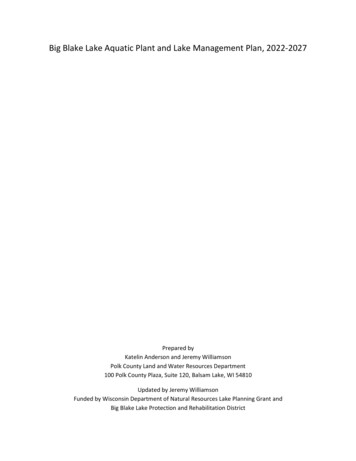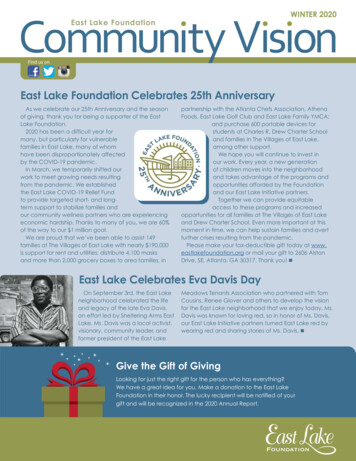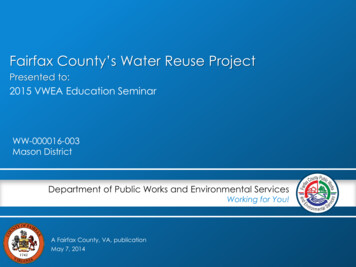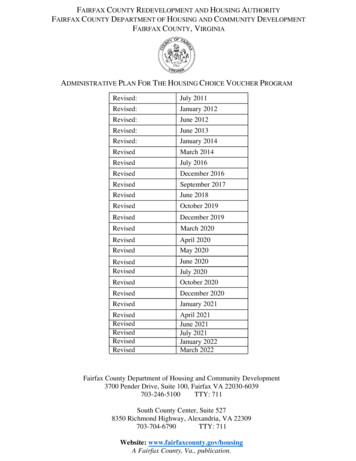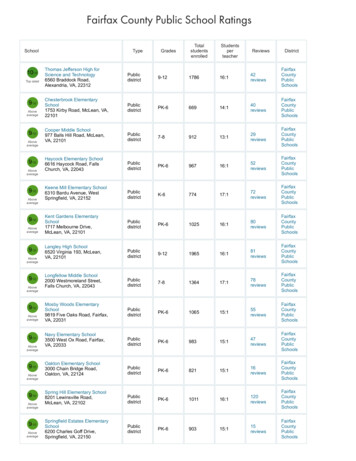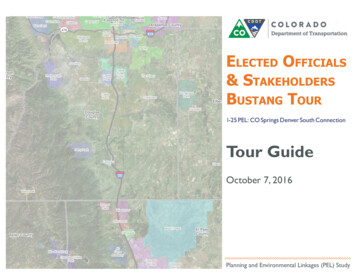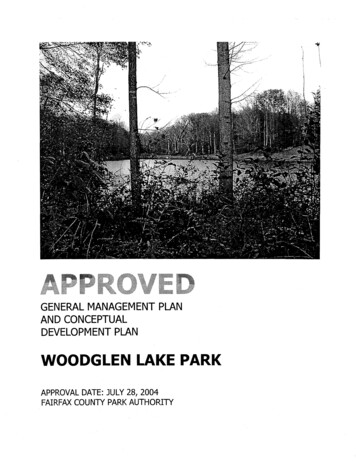
Transcription
GENERAL MANAGEMENT PLANAND CONCEPTUALDEVELOPMENT PLANWOODGLEN LAKE PARKAPPROVAL DATE: JULY 28, 2004FAIRFAX COUNTY PARK AUTHORITY
FAIRFAX COUNTY PARK AUTHORITYWOODGLEN LAKE PARKGENERAL MANAGEMENT PLAN ANDCONCEPTUAL DEVELOPMENT PLANJULY 2004Winifred S. Shapiro, Chairman, Braddock DistrictGilbertS. McCutcheon, Vice Chairman, Mt. Vernon DistrictJennifer E. Heinz, Secretary/Treasurer, At-LargeHarold L. Strickland, Sully DistrictJoanne E. Malone, Providence DistrictKenneth G. Feng, Springfield DistrictFrankS. Vajda, Mason DistrictKevin J. Fay, Dranesville DistrictEdward R. Batten, Lee DistrictGeorgette Kohler, At-LargeGeorge D. Lovelace, At-LargeGlenda Blake, Hunter Mill DistrictSENIOR STAFFMichael A. Kane, DirectorTimothy K. White, Deputy DirectorLynn S. Tadlock, Director, Planning and Development DivisionCharlie Bittenbring, Acting Director, Park Services DivisionMiriam C. Morrison, Director, Administration DivisionCindy Messinger, Director, Resource Management DivisionBrian Daly, Director, Park OperationsJudith Pedersen, Public Information OfficerPROJECT TEAMKirk Holley, Branch ManagerJenny Pate, Project ManagerTodd BoltonHeather MelchiorGreg PhippsJohn Rutherford
WOODGLEN LAKE PARKTABLE OF CONTENTSI.IntroductionA.Purpose and Description of the Plan. 3B.Property Location and Description . 3C.Ownership and Land Use History . 3II. Park Purpose and SignificanceA.Park Purpose . 4B.Significance Statement . 4C.Visitor Experiences . 4D.Park Classification . 4III. Existing ConditionsA.Slopes . 4B.Soils . 5C.Natural Resources . 8D.Cultural Resources . 11E.Access . 12F.Utilities . 12G.Existing and Planned Land Use . 12H.Countywide Trail Plan . 12I.Existing Facilities . 13IV. Public Law PL-566V.VI.A.Background . 13B.Current Inventory . 13C.Current Inspection Cycle . 13D.Current Service Level . 14Needs AssessmentA.Nearby Parks and Schools . 14B.Needs Assessment Statement. . 17Green Infrastructure Statement . 18VII. Management FrameworkA.Resource Protection Zone . 19B. Entrance Zones . 19GENERAL MANAGEMENT PLAN . 20
Page 2WOODGLEN LAKE PARKVIII. Description of Concept Plan ElementsA. Entrance Improvements . 21B. Trails . 21C. Residential Education . 21D. Resource Management . 22APPENDIXWoodglen Lake Park Species List . 26Policy 202- Wildlife Conflict Resolution Policy . 28Draft Encroachment Brochure Text . 29
WOODGLEN LAKE PARKI. INTRODUCTIONA. Purpose and Description of the PlanThe purpose of the General Manage ment Plan {GMP) is to serve as a guidefor all future planning and program ming of this park.This G MP {see page 20) describes theexisting natural and cultural resourcesof the park, as well as other existingconditions. General Management Plansare meant to be flexible, to change withthe changing needs of park visitors.Every GMP should be updated periodi cally, to reflect changes that haveoccurred both on and off-site.The purpose of the ConceptualDevelopment Plan {CDP) is to describehow the park will be managed andwhat activities should be associatedwith that management.B. Property Location and DescriptionWoodglen Lake Park is a wooded 54.4acre community park in the BraddockSupervisory District. The lake surfaceis 12.8 acres in size. It is located at10617 Zion Drive in Fairfax, Virginia. Itis generally bounded by Zion Drive tothe north and a vacant parcel of landand then the Norfolk SouthernRailroad to the south. It is surroundedby residential development, includingMiddleridge, Fairfax Club Estates, andBonnie Brae. It is immediately adjacentto the Bonnie Brae Elementary Schoolto the southeast.Page3C. Ownership and Land Use HistoryWoodglen Lake was constructed in thelate 1970's through 1980 as part of apilot, watershed-wide water qualitymanagement program known as PublicLaw 566 {PL566). The majority of theWoodglen Lake Park property wasacquired by the County from a varietyof private owners and developers in themid-70s for this construction, thenwas transferred to Fairfax County ParkAuthority from the Board ofSupervisors in October 1999. OtherPL566 lakes in Fairfax County includeBarton, Braddock, Mercer, Royal, andHuntsman Lakes. These lakes aredesigned to capture sediment toprevent it from moving downstream.According to the Annual Report on theEnvironment, 2003, produced by theFairfax County Environmental QualityAdvisory Council, the lakes areinspected annually for the damstructure, but are not monitored forbiological or chemical parameters.Approximately half of Woodglen Lakecould fill in with sediment beforedownstream water quality would be
Page 4WOODGLEN LAKE PARKadversely impacted. In 2000, testsshowed that the lake was filled withsilt at 5% of its capacity.Since Woodglen Lake is a stormwatermanagement facility, it is maintainedby the Department of Public Worksand Environmental Services.II. PARK PURPOSE ANDSIGNIFICANCEA. Park Purpose: What is the purposeof the park?Park Purpose statements are intendedto provide an umbrella for planningand decision making. If a proposed useconflicts with any one of the purposeslisted, it will be considered anincompatible use. By establishing parkpurposes, future plans can remainflexible, as legislative requirements andvisitor preferences change. Thepurpose of Woodglen Lake Park is to: C. Visitor Experiences: What will thevisitor experience at this park?Visitors will be able to enjoy thewooded natural area and walkinformally around the small lake.D. Park ClassificationWhen acquired, Woodglen Lake Parkwas classified as a Community Parkbased on its acreage. With this planthe classification will be changed to aNatural Resource Park. This subset ofthe Countywide Park classification isintended to preserve, protect andperpetuate areas of sensitive or uniqueenvironmental, ecological, and scenicvalues in Fairfax County. Developmentwhich does not adversely affectecological functions and whichenhances awareness of resource valuesis appropriate. Interpretive (education)facilities and structures includingorientation kiosks, hiking, biking andequestrian trails as designated, signsand benches are acceptable forms ofpark development. The size of the parktype varies according to the extent ofresources to be protected.Preserve, protect, and interpretnatural resourcesIII. EXISTING CONDITIONSB. Significance Statement: Why isthis park important?Woodglen Lake Park is an importantcomponent of the park system inBraddock District. Each park in thisarea of the county (see page 16) playsan important role in protectingresources and providing recreationalopportunities for the citizens of thecounty.A. SlopesSlopes on the site are between 2-7 % inthe stream valleys, but are steeperthan 10% on either side of the lake.Generally the southwest and northeastsides of the lake are steeper withslopes well over 10%, in the 14-25%category. Area of slopes greater than10% also occur along the tributary tothe west.
Page 5WOODGLEN LAKE PARK8 nnie·BraeE!em ntary' School'. . . . . . . . . . . . . . . . . . . . 0-5%fffli\\\\1 5-1 0%\ Nl !!R over 10%SLOPESWOODGLEN LAKE PARK2000200 Feet·
Page 6WOODGLEN LAKE PARKB. Soilsand gravelly areas.This park is located in the Piedmontupland physiographic province in thecentral portion of Fairfax County. Itoccurs east of the Triassic Basin andwest of the Coastal Plain. The provinceis underlain by metamorphic rocks,predominantly schist, granite, gneissand greenstone. Remnants of theCoastal Plain terrace may be found onhigh, broad ridge tops in the easternhalf of the province. A well-dissected,dendritic drainage pattern occursthroughout the province. The hilltopsare typically fairly wide and rolling,except in places along the lowertributaries of large streams. Here, V shaped valleys with steep slopes andnarrow ridge tops occur. All of the soilson the site are silt loams with theexception of the Mixed Alluvial Soil,which is a soil type characteristic ofthe flood plain areas in the county.(8A ) Worsham Silt Loam is alsoclassified as a hydric soil with a highprobably of wetlands. It is poorlydrained, gray, flat and occurs alongfoot slopes and upper drainageways. Itis subject to seepage waters fromsurrounding slopes. It is rated poor formost development.( lA) Mixed Alluvial Soil is derived fromrecent soil materials which havewashed from the uplands anddeposited along the stream bottoms. Itconsists mainly of somewhat poorlyand poorly drained soils and mixed soilmaterials including very sandy areasand gravelly bars. It is subject tofrequent flooding and needs drainagein many places for any developed uses.More than half of the land area of thepark is this soil type, which ischaracterized as a hydric soil with ahigh probability of containingwetlands. Stream bank erosion withinthese soils may result in undercuttingof embankments on adjacentproperties. This soil is rated poor in thesilty and silty clay areas for road andstreet subgrade, but good in the sandy(lOB ) Glenville Silt Loam is a deep,moderately well to somewhat poorlydrained soil in the upper courses ofdrainageways, in swales in uplands, insaddles between major drainage shedsand on lower footslopes influenced byseepage. The water table is seasonallyhigh and the soil rates fair to poor formost development.(20B ) Meadowville Silt Loam is adeep, brown moderately well drained,friable, fertile soil that is derived fromrecent colluvial materials which havewashed mainly out of the Glenelg,Elioak, and Manor soil areas. The soilaccumulates seepage water from thesurrounding slopes and has a highwater table during wet seasons. Thesoil rates poor for most development.(21D2) Manor Silt Loam, hilly phase isa strongly sloping, excessively drained,weakly developed, highly micaceoussoil that is derived from quartz sereciteschist rock materials. It is difficult tocompact and susceptible to erosion. Itrates good to fair for development.(32B2, C2) Fairfax Silt Loam,undulating phase, is a moderately well
Page7WOODGLEN LAKE PARK1A - Mixed Alluvial SoilSA - Worsham Silt LoamlOB - Glenville Silt Loam20B - Meadowville Silt Loam2102 - Manor Silt Loam32 82, C2- Fairfax Silt Loam55 C2 1 02- Glenelg Silt LoamSOILSWOODGLEN LAKE PARK200 ! BetI
Page 8WOODGLEN LAKE PARKdrained soil that is developed on oldhigh lying land areas. It usuallyoccupies ridge tops and is fairlyextensive. Internal drainage ismoderately slow because the soil has apan layer that usually occurs 28 to 30inches below the surface. The soil israted good to fair for development,including road subgrade materials.(55 C2, D2)- Glenelg Silt Loam is amoderately deep, well-drained brownloamy soil formed in materialsweathered from quartz mica schistrocks. This soil is located on the upperslopes and hilltops in the Piedmontuplands. It is extensive and typicallyfound in large tracts ranging to severalhundred acres in size. It has desirableproperties for many uses and ratesgood for most development.C. Natural ResourcesStreams and WetlandsTwo perennial streams are present onthe project site: Sideburn Branchflowing north to south into WoodglenLake and an unnamed tributaryflowing through the western portion ofthe site. Their confluence is at thenorthern end of the lake. Several smallintermittent streams contribute to thelake as well. One is located north-eastof the lake and contributes to awetland system before connecting tothe lake. A second one is locatedapproximately midway on the west sideof the lake.The presence of hydric soils, MixedAlluvial Soil and Worsham Silt Loam,indicates there is a likelihood thatwetlands may be found within thearea. Several potential wetland areasexist on the site. A small wet area islocated on the southern floodplain ofthe western tributary of SideburnBranch. Various wetland areas arelocated within the floodplain ofSideburn Branch below the dam.Another area is present along the lowereast side of the lake, where historicallya small stream entered SideburnBranch. Another wetland system isassociated with the small tributary onthe east side of Sideburn Branch, justnorth of the lake and below a formerde-watering basin. A small seep ispresent just north of this basin on theeast side of the access road.Resource Protection AreasThe Fairfax County Chesapeake BayOrdinance maps indicate that almostthe entire site falls within a ResourceProtection Area (RPA). Only smallportions of the site, generally on thesteeper slope sections, fall outside theRPA, but are still within the ResourceManagement Area (RMA).Forest CoverAlmost the entire area surroundingWoodglen Lake is in forest cover. Theforest cover in the stream valleys andlower elevations of the site is generallya mixture of larger bottomland forestspecies such as tulip poplar(Liri.odendron tulipifera) and red maple(Acer rub rum). Their age is estimated tobe 80-100 years. Understory shrubsvary, but include spicebush (Linderabenzoin), American holly (flex opaca),flowering dogwood (Comus florida),
WOODGLEN LAKE PARKarrowwood (Viburnum den tatum) andblack haw (Viburnum prunifolium).Woody vines include poison ivy (Rhusradicans), greenbriar (Smilaxrotundifolia), grapes (Vitis sp.) andJapanese honeysuckle (Lonicerajaponica). On the higher and steeperslopes of the project site, various oakspecies are included in the mix, inparticular white oak (Quercus alba)and northern red oak (Quercus rubra).Starting east of Broadwater Drive, thetulip poplar j maple forest on the southside of the stream has a denseovergrown understory of Americanholly, spicebush, greenbriar, Japaneseholly, Japanese honeysuckle andpoison ivy. Black gum (Nyssa sylvatica)and flowering dogwood are alsopresent. This forest is of mediumquality. Going further east, oneencounters a lower, wetter area withinthe floodplain, which also receivesrunoff from the adjacent houses.Further east the shrub layer thins outand the overall health of the forestimproves. Additional species present inthe canopy layer include white oaksand beech (Fagus grandifolia)especially on some of the higher andsteeper slopes near the edge of theproperty.The forest on the north side is probablysomewhat younger than the forest onthe south side of the stream sincethere are still Virginia pines (Pinusvirginiana), a pioneer species, presentin the mix of tulip poplars and maples.Just before reaching the lake, theproperty widens and the forest on thenorth side of the lake is similar to thePage 9high quality forest on the south side,with a mixture of tulip poplars, redmaples, and white oaks, and Virginiapine remnants on the highest part ofthe property.Continuing along the western edge ofthe lake the forest compositionchanges little, with the canopy stilldominated by tulip poplars, maplesand white oaks. Aerial photography of1937 shows similar forest cover alongthe stream valleys of both SideburnBranch and its western tributary.Spicebush, arrowwood, blackberries(Rubus argutus), American holly as wellas hazelnuts (Corylus americana) arepresent along the edge of the lake.Further south on the steeper, narrowslopes, mountain laurel becomes partof the understory mix. Greenbriar andpoison ivy are present throughout, asis the invasive Japanese honeysuckle.South of the dam the forest on thewest side of Sideburn Branch is againsimilar to the forest cover describedabove, with the lower elevations mostlydominated by tulip poplar and redmaples and the higher elevationsseeing a higher percentage of whiteand red oaks mixed in with the othertwo species. Just east of SideburnBranch is a younger (20-30 years)forest dominated by red maples andtulip poplars. This area was clearedaround 1970 when the sewer line wasconstructed. Additional clearing tookplace during construction of the lake(1980). Large areas of the forest withinthe floodplain of Sideburn Branch arewetlands, as is indicated by thepresence of hydric soil in this location,
Page 10WOODGLEN LAKE PARKhummocky saturated soils and manyherbaceous and shrub wetland speciesin addition to the canopy species. Boththe younger (east side) and older (westside) portions of the forest containwetlands, but it is particularly evidenton the east side, where the floodplainis wider and flatter and runoff from thehillside tends to pool on top of clayeysoils, and contributes to the saturationof the soil. A pathway/ clearing locatedon the east side of the stream at thebottom of the slope, crosses throughseveral wetland areas.The forest cover on the slopes on theeast side of Sideburn Branch is also arelatively young (approx. 50 years)forest, with Virginia pines present onthe upper slopes and stunted redcedars (Juniperus virginiana) spreadthroughout. Other species present inthe canopy include white and red oak,tulip poplar, high and low bushblueberries and black haw.There is apparent encroachment ontopark property to the east of BroadwaterDrive. A substantial area to the edge ofthe stream has been mowed andmaintained as lawn. Additionalencroachment appears to be presenton the north side of the tributary toSideburn Branch; brush has beencleared or areas have been mowed upto the edge of the stream in severaldifferent locations. The areas ofmowing exist in various locations onboth sides of the lake as well. The eastside of the lake has seen extensiveclearing of underbrush and forestareas. The small section of remainingforest is made up of a mixture of oaks,tulip poplars, beech, Virginia pines,American holly and mountain laurel.The lower section adjacent to the lakeis meadow, which has been mowed insome locations.North of the lake, along the east side ofSideburn Branch, there is a former de watering basin (constructed in the1980-1982 time period). Just below thebasin is another area of wetlands,dominated by maples and spice bush,which receives additional runoff from asmall tributary coming from the east.The forest along this small tributary isa mix of tulip poplars and maples.Their size is generally somewhatsmaller than what is found along themajor tributary coming from the west.Virginia pine is present along thebanks of Sideburn Branch west of theSWM area and these are remnants of aVirginia pine forest that extended tothe west.An access road runs from Zion Drivealong the east side of the SWM areatowards the lake. The forest north ofthe SWM area is again dominated bytulip poplars and maples ofconsiderable size and is probably alsoin the 80-100 year age range. East ofthe access road is a small wetland seepdominated by red maples, tulip poplar,alder, arrowwood, various herbaceousspecies and greenbriar. North of theseep the forest remains similar withlarge tulip poplars, red maples and anoccasional beech.The forest on the west side of theaccess road is similar in age and
WOODGLEN LAKE PARKPage 11composition as what is found on theeast side of the road: floodplain forestdominated by tulip poplars and redmaples, with an understory ofspicebush, black haw and greenbriar.There are some very large specimenslocated throughout this area, whichpossibly are older than 100 years.Japanese honeysuckle and Japaneseholly are present in large quantity. Onespot along the west side of the accessroad is overgrown with the invasiveEnglish ivy (Hedera helix) both on theground as well as creeping up severallarge trees. This area could be targetedfor invasive species control, since theEnglish ivy is only present in a limitedarea.were noted. Two previouslydocumented Native American siteswere known to be present at thewestern end of the parcels, but havebeen destroyed by housingdevelopment and construction of thedam and lake. A new site was foundduring the current survey. It lies on anarrow bench south of the east to westrunning tributary into the lake. Thissite consists of a quartz reduction site,where Native Americans would havecamped and made stone tools. Severalexpedient quartz tools and significantamounts of debitage (the flakes andchips of stone resulting from themanufacture of stone tools) werefound.D. Cultural ResourcesDuring the 18th century, theproperties were part of a large parcel ofagricultural land. Preliminary archivalresearch of the properties in the areashowed no evidence of existingstructures and no remaining historicstructures. During the survey, noevidence of domestic structures or millsites was noted.A preliminary background review ofWoodglen Lake Park has beencompleted and the area has undergonepedestrian archaeologicalreconnaissance. All of the area wassurveyed, and judgmentally placedShovel Test Pits (STPs) were excavatedin the area of moderate to highpotential for archaeological sites.In times prior to European Contact,these parcels along Woodglen Lakewould have been attractive lands forNative American people, with amplewater resources. The streams, part ofthe upper western headwaters ofPohick Creek, also would haveattracted Native Americans because ofthe abundance of game for hunting, aswell as cobbles for the manufacture ofstone tools. During the pedestriansurvey, outcrops of quartz, animportant resource for native peoples,While Woodglen Lake Park has fewknown cultural resources, thelikelihood that additional NativeAmerican sites exist is low. Thepedestrian archaeologicalreconnaissance surveyed all of theareas that potentially could have sitesand only one new site was found.There are a number of Civil War Sitesin the vicinity, as the property is southof Braddock Road, a majorthoroughfare during the war. Two CivilWar sites located just west of the parkboundaries were destroyed by urban
Page 12WOODGLEN LAKE PARKdevelopment. Relic hunters reportedfinding camp-related artifacts in thisarea prior to and during constructionand that both Federal and Confederateartifacts have been found.As most of the archaeological siteslocated within Woodglen Lake Parkhave been destroyed or seriouslycompromised by both suburban andpark development, the sites located onthe western edge of park warrant nofurther preservation methods. Thenewly identified archaeological sitelocated just west of the lake on thesouth side of the tributary of the lakeis likely to contain information onNative American themes of stone toolmanufacture technology, subsistence,and overall site formation andstructure. If in the future any grounddisturbing activities are planned forthis location, the site will requireadditional archaeological survey, andfollowing that, possibly additionaltesting and excavation.E. AccessThe most visible access to the park ison Zion Drive. There are also existingconnection points to severalsubdivision streets: Paynes ChurchDrive, Landmark Place, GoldeneyeLane, and Fireside Court.F. UtilitiesElectricity, water, and sewer areavailable on various parcels of the site.G. Existing and Planned Land UseThe park is zoned a combination ofzonings: R-1, R-3, and PDH- 3; theareas surrounding the park are zonedthe same three zonings, with theBonnie Brae community being zonedR-2. Almost all of the surroundingarea is single-family residential, withthe exception of the Norfolk SouthernRailroad and properties to the south ofthe rail line. As you cross Roberts andGuinea Roads, townhouses are addedto the mix.The Comprehensive Plan for FairfaxCounty, Virginia for Area III, thePohick Planning District, Main BranchCommunity Planning Sector states thefollowing: "A remarkable amount oftreed landscape remains in olderneighborhoods which, when combinedwith the stream valleys, contributes tothe rural character of the residentialareas.This entire sector is classifiedas Suburban Neighborhood. Infilldevelopment in these neighborhoodsshould be of a compatible use, typeand intensity. " Regardingtransportation, the plan references thefuture widening and extension ofGuinea Road from Sideburn Road toRoute 123 within the existing 90 footright of way. The plan includes arecommendation to re-evaluate thenecessity of this road and otheroptions once the Roberts Roadoverpass has been completed andresultant traffic patterns are betterunderstood.
WOODGLEN LAKE PARKH. Countywide Trail PlanThe County Comprehensive Planshows a 6' wide paved trail along ZionRoad. This trail exists along thefrontage of the park. The main north south trails on the plan are alongRoute 123. A new countywide trail, TheSouth County East-West Trail, isproposed to follow Adare Drive andJohn Ayres Drive to Goldeneye Laneand south to the stream valley trailalong Sideburn Branch of the Pohick.This trail is not planned to touch thepark, but trails within the park andconnecting to Goldeneye Lane couldpossibly become part of this trailsystem.I. Existing FacilitiesThe site is not developed.IV. PUBLIC LAW PL-566A. BackgroundIn January 1967, the BOS, underPublic Law PL-566, approved thePohick Creek Watershed Work Plan.This watershed work plan wassponsored and prepared by theNorthern Virginia Soil and WaterConservation District and the FairfaxCounty Board of Supervisors throughits planning staff. Technical assistancewas provided by the Soil ConservationService and Forest Service of the U. S.Department of Agriculture, cooperatingwith the Virginia Department ofForestry of the Department ofConservation and EconomicDevelopment. Other State and Federalagencies assisting were the Soil andPage 13Water Conservation Commission, theAgricultural Stabilization andConservation Service, the VirginiaDepartment of Highways andTransportation, the AgricultureExtension Service, the VirginiaCommission of Game and InlandFisheries, and the U. S. Fish andWildlife Service.The program establishednewguidelines for land treatment inurban areas. The guidelines provide anorderly system for storm drainage tohelp control flooding, erosion andsedimentation, and preserve n:;:tturalstream channels. Water impoundmentstructures, or damsites, are an integralpart of the watershed project.Construction of six damsites wascompleted, the first in 1970 and thelast in 1985. Each site serves aparticular sub watershed (of the PohickCreek Watershed) containing differentsoil types and various amounts ofpervious and impervious cover, factorswhich contribute to stormwater surfacerunoff and natural erosion. The lakesserve to trap sediment washed fromupstream sources. The dams weredesigned, primarily, as stormwaterquantity control facilities and with asediment pool capacity for projected100-yr sediment accumulations. Theimpoundments, in total, serve awatershed area of 22,690 acres with anestimated population in excess of100,000. In addition to serving asflood control facilities, the lakescontribute to water quality andsupport passive recreational activities(i.e., fishing, non-motorized boating,etc.).
Page 14WOODGLEN LAKE PARKB. Current InventoryDamsite 1: Lake MercerDamsite 2: Lake BartonDamsite 3: Woodglen LakeDamsite 4: Lake RoyalDamsite 7: Lake BraddockDamsite 8: Hunstman Lakeconstruction. These inspections satisfythe State requirements for dam safety.The permit issued by the State tooperate the dam is valid for six years.Re-issuance of the permit is tied to themost recent biennial inspection andcompliance with all appropriate safetyand operational requirements of theState.C. Current Inspection CycleD. Current Service LevelAll PL-566 dams are formally inspectedannually via a joint inspection withrepresentatives of the Department ofPublic Works and EnvironmentalServices, the Fairfax County ParkAuthority, the Virginia Department ofConservation and Recreation, the U.S.Department of Agriculture and theNorthern Virginia Soil and WaterConservation District. Theseinspections are normally conducted inthe fall and serve to identify any safetyor operational area in need ofcorrective action. In addition, abiennial inspection is conducted undercontract to an engineering firm withexperience and expertise in damBased on the formal inspectionsmentioned above and other informalinspections conducted by County staff,a work program is established tocorrect any deficiencies an
Woodglen Lake Park property was acquired by the County from a variety of private owners and developers in the mid-70s for this construction, then was transferred to Fairfax County Park Authority from the Board of Supervisors in October 1999. Other PL566 lakes in Fairfax County include Barton, Braddock, Mercer, Royal, and Huntsman Lakes.
